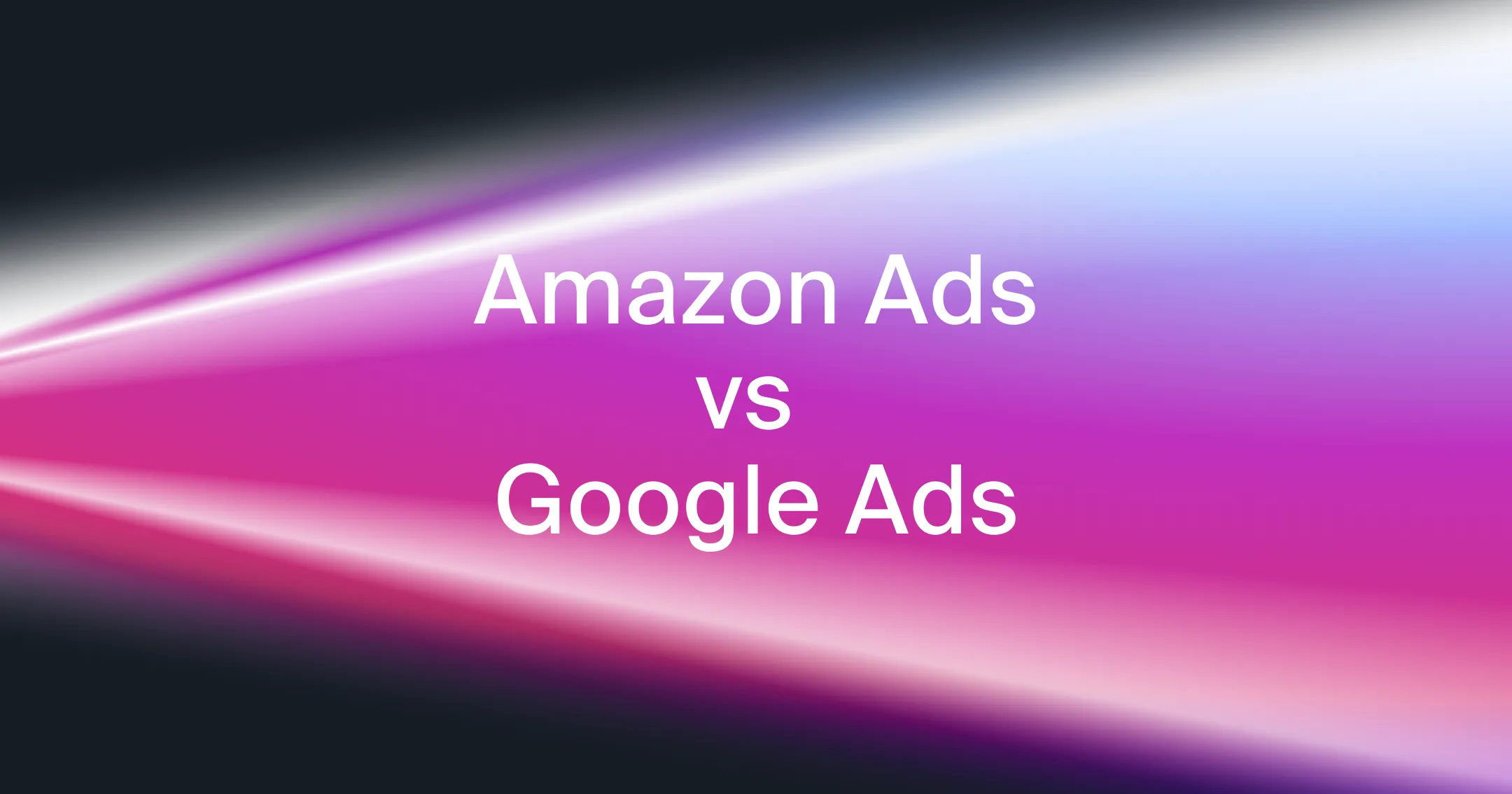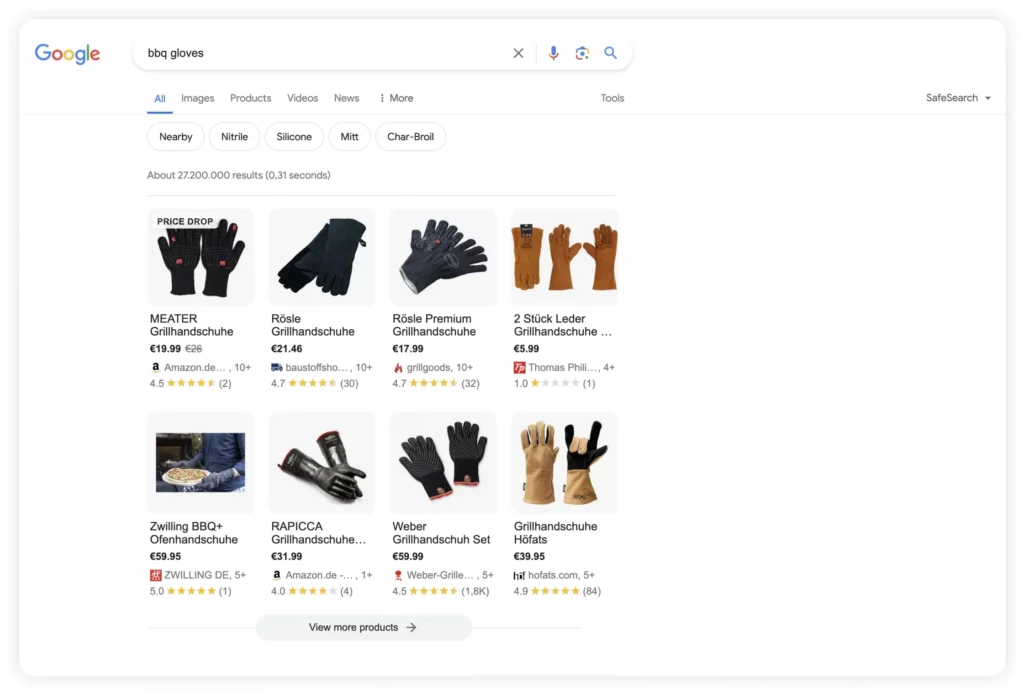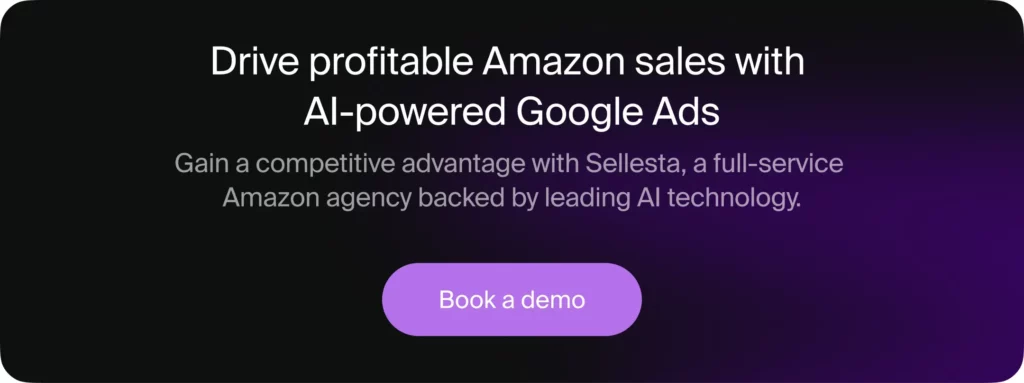
You’ve found your niche.
You’ve planned your product ranges.
You’ve created your listings and you’ve launched your brand on Amazon.
You’re generating sales, but you know you can get more, faster. So, you turn to advertising, and find you have two options — the native Amazon Ads, or the external, but widely-renowned Google Ads.
As a marketer, which is better for your goals, and as a seller, which is going to work best for your specific products?
At Sellesta, we’re here to answer these questions. Join us as we delve into the specifics of Google Ads and Amazon Ads, helping you make an informed decision for your Amazon advertising strategy.

Table of Contents
Google Ads 101: Snapshot Overview
Google Ads are a powerful tool in the digital marketer’s toolkit, offering unparalleled opportunities to connect with potential customers. They operate across the vast Google network, which includes not only search results but also websites, videos, and apps that partner with Google. This broad reach means your ads can appear just where your audience is most likely to see them.
Google Ads offers a variety of ad formats, each designed to meet different advertising needs:
- Search Ads: Text-based ads that appear in Google search results.
- Display Ads: Visual ads that show on websites within the Google Display Network.
- Video Ads: Engaging video commercials on platforms like YouTube.
- Shopping Ads: Product listings that appear in Google Shopping and search results. Amazon products can’t be advertised here, as Google requires you to claim ownership of the website you’re advertising products on.
- App Ads: Promotions for mobile apps across Google’s networks.
The target audience for Google Ads is primarily individuals in the research and consideration phases of their buying journey. When people are actively seeking information, products, or services, Google Ads can strategically position your brand in their search results, capturing attention at a pivotal decision-making moment.
This targeted approach makes Google Ads an invaluable asset for businesses aiming to boost visibility and engage potential customers effectively.

Pros of Google Ads
Google Ads hold a number of benefits for Amazon sellers to take advantage of. Let’s look at them in more detail:
Extensive reach across the internet: Google is the world’s most popular search engine, being used by 8.5 billion people on a daily basis. That’s a lot of potential customers. As a result, Google Ads offers unmatched exposure, helping you get eyes on your products, drive traffic to your listings, and tap into previously unreached audiences.
Versatility in ad formats: From text-based ads that appear at top of search to dynamic videos that engage users directly within their favorite websites, the wide range of ad formats allows for strategic ad campaigns that closely align with your marketing goals.
Detailed targeting: Google Ads’ advanced targeting capabilities offer precision in reaching specific audiences. Advertisers can segment their audience based on detailed criteria like demographics, interests, and online behavior, ensuring that their message reaches the most relevant and responsive viewers.
Benefits for brand awareness and engagement: Real-time placement means your ads appear just as potential customers are actively searching for related products or services. This timely visibility is ideal for businesses looking to quickly build brand recognition and engage with interested customers right when they’re most receptive.

Cons of Google Ads for Amazon Sellers
Conversely, there are also some distinct disadvantages of Google Ads that Amazon sellers should take into account before investing in a strategy:
Cost challenges in competitive sectors: Google Ads can get costly, quickly – especially in competitive niches. The nature of Google’s search ads means you pay per click, so if your targeting isn’t dialed in, or if there are lots of competitors also vying for your audience’s attention, your budget can get soaked up quickly.
Complexity in campaign management: The multiple ad formats and placements can make Google Ads difficult for newcomers to understand. As a result, setting up and optimizing campaigns is best done by a professional Amazon advertising agency.
Comparatively lower conversion rates: On top of higher costs per click, Google Ads often see lower conversion rates than Amazon Ads. On Amazon, it’s not uncommon to see conversion rates of 40%. Google Ads, on the other hand, come in at a much lower number than this, hovering at around 3-10%. For brands with lower Recommended Retail Prices (RRPs) or less Customer Lifetime Value, this can make it hard to drive a stable profit from Google Ads without detailed conversion rate optimization work.
Amazon Ads 101: Snapshot Overview
Next, let’s take a look at Amazon Ads, a platform that allows sellers to advertise their products directly on Amazon. This service is designed to increase visibility and sales by showcasing products directly on the Amazon marketplace to consumers who are already in a buying mindset.
Amazon Ads run in
- Sponsored Products: These are ads for individual product listings on Amazon. They appear in search results and product detail pages, blending in with organic listings.
- Sponsored Brands: These ads promote a brand and its product portfolio. They feature a custom headline, logo, and a selection of products, appearing at the top of search results.
- Sponsored Display Ads: These ads target consumers based on their shopping behaviors and appear both on and off Amazon. These are ideal for re-engaging shoppers who viewed specific products.
- Stores: Custom multi-page shopping experiences within Amazon for individual brands, allowing sellers to showcase their brand story and product range.

Pros of Amazon Ads
Native to the Amazon platform, Amazon Ads come with a number of powerful benefits, often making them the first choice for sellers:
High conversion rates: Amazon Ads operate within a direct sales environment, leading to higher conversion rates. Shoppers on Amazon typically have a clear intent to purchase, making them more likely to convert when they encounter relevant ads.
Effectiveness in driving immediate sales: In contrast to external advertising channels like Google and Facebook, ads on Amazon are uniquely effective in facilitating immediate sales.
The platform’s design encourages quick purchasing decisions, directly benefiting sellers.
Powerful behavioral targeting: Amazon Ads offer sophisticated targeting options based on consumers’ shopping behaviors and search history. This level of precision enables sellers to reach the most relevant audience, increasing the likelihood of sales.
Cons of Amazon Ads
Despite its benefits, there are a couple of downsides to Amazon Ads that sellers need to take into account when investing in their strategy:
Limited to Amazon platform: Amazon Ads are only available within the Amazon ecosystem. This means you’re tied to promoting products listed on Amazon, trapping you into platform fees and limiting the customer and sales data you get access to. This can present a challenge for brands that rely on retention to drive profit.
Tied to existing product demand: On Amazon, it can be difficult to sell products that are completely new to the market. This is simply because, as a marketplace, it’s easier to capitalize on existing demand, as opposed to generating new demand. If customers aren’t actively searching for the product you’re offering, you will struggle to drive sales.
Intense competition within product categories: Unless you’re diving into a relatively untapped niche, be prepared to meet fierce competition with Amazon Ads as other sellers vye for the top spots on search results pages. Increased costs per click can make it difficult for sellers to gain the sales traction they need to scale.
Dependence on Amazon’s algorithm: As with any marketing channel, Amazon sellers are at the mercy of the platform’s algorithm. Changes in the algorithm can affect ad performance unpredictably, requiring constant adaptation and optimization from sellers. Amazon’s algorithm changes can be significantly mitigated with AI-powered listing optimization and advertising.
Amazon vs Google Ads: Choosing the right platform for you
Navigating the digital landscape requires choosing the right platform that aligns with your business needs and goals. Let’s break down the specifics of Google Ads and Amazon Ads to help you work out which to use and when, to help you build your digital marketing strategy:
The case for Google Ads:
When your products have a higher Retail Recommended Price (RRP), providing a substantial margin to cover the cost-per-click (CPC), Google Ads might be your ideal platform. This is especially true for businesses looking to broaden their market reach beyond Amazon, or for brands that have found their audience size on Amazon is limited. Additionally, Google Ads are beneficial for those seeking to grow their customer base beyond what they’ve achieved on Amazon.
The case for Amazon Ads:
For businesses focused on immediate, direct product sales, Amazon Ads are a more suitable choice. They excel in environments with a high intent to purchase, particularly within the Amazon ecosystem. If maximizing conversions on Amazon is your primary goal, these ads offer a targeted, audience-specific strategy.
Maximize the benefit of both channels with Sellesta
Finding the right advertising channel – or managing multiple channels at the same time – can be a tricky, time-consuming task for Amazon businesses. Sellesta makes it easy. An e-commerce advertising agency to help businesses grow sales on marketplaces and online stores, Sellesta’s team of experts leverages the power of AI and machine learning to create, optimize and scale Google and Amazon Ads campaigns.
Discover the true potential of Amazon and Google Ads for your brand. Book a call with one of our marketplace experts now.


